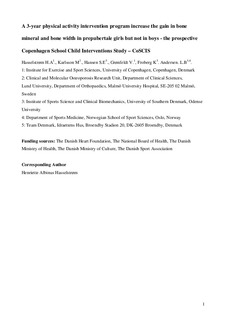| dc.contributor.author | Hasselstrøm, Henriette A. | |
| dc.contributor.author | Karlsson, Magnus K. | |
| dc.contributor.author | Hansen, Stig Eiberg | |
| dc.contributor.author | Grønfeldt, Vivian | |
| dc.contributor.author | Froberg, Karsten | |
| dc.contributor.author | Andersen, Lars Bo | |
| dc.date.accessioned | 2009-10-20T12:37:15Z | |
| dc.date.issued | 2008-10-07 | |
| dc.identifier | Seksjon for idrettsmedisinske fag / Department of Sports Medicine | |
| dc.identifier.citation | Calcified Tissue International. 2008, 83(4), 243-250 | en |
| dc.identifier.issn | 0171-967x | |
| dc.identifier.uri | http://hdl.handle.net/11250/170769 | |
| dc.description | I Brage finner du siste tekst-versjon av artikkelen, og den kan inneholde ubetydelige forskjeller fra forlagets pdf-versjon. Forlagets pdf-versjon finner du på www.springerlink.com: http://dx.doi.org/10.1007/s00223-008-9166-x / In Brage you'll find the final text version of the article, and it may contain insignificant differences from the journal's pdf version. The original publication is available at www.springerlink.com: http://dx.doi.org/10.1007/s00223-008-9166-x | en |
| dc.description.abstract | The aim of this study was to evaluate the effect of increasing the amount of time spent in physical education classes on bone mineral accrual and gain in bone size in prepubertal Danish children. A total of 135 boys and 108 girls, aged 6–8 years, were included in a school-based curriculum intervention program where the usual time spent in physical education classes was doubled to four classes (180 min) per week. The control group comprised age-matched children (62 boys and 76 girls) recruited from a separate community who completed the usual Danish school curriculum of physical activity (90 min/week). Dual-energy X-ray absorptiometry was used to evaluate bone mineral content (BMC; g), bone mineral density (g/cm2), and bone width at the calcaneus and distal forearm before and after 3 years of intervention. Anthropometrics and Tanner stages were evaluated on the same occasions. General physical activity was measured with an accelerometer worn for 4 days. In girls, the intervention group had a 12.5% increase (P = 0.04) in distal forearm BMC and a 13.2% increase (P = 0.005) in distal forearm scanned area compared with girls in the control group. No differences were found between the intervention and control groups in boys. Increasing the frequency of physical education classes for prepubertal children is associated with a higher accrual of bone mineral and higher gain in bone size after 3 years in girls but not in boys. | en |
| dc.format.extent | 93438 bytes | |
| dc.format.mimetype | application/pdf | |
| dc.language.iso | eng | en |
| dc.publisher | Springer | en |
| dc.subject | exercise intervention | en |
| dc.subject | bone mineral density | en |
| dc.subject | bone size | en |
| dc.subject | child | en |
| dc.subject | population-based | en |
| dc.title | A 3-year physical activity intervention program increases the gain in bone mineral and bone width in prepubertal girls but not boys: the Prospective Copenhagen School Child Interventions Study (CoSCIS) | en |
| dc.type | Peer reviewed | en |
| dc.type | Journal article | en |
| dc.subject.nsi | VDP::Medical disciplines: 700 | en |
| dc.source.pagenumber | 243-250 | en |
| dc.source.volume | 83 | en |
| dc.source.journal | Calcified Tissue International | en |
| dc.source.issue | 4 | en |
